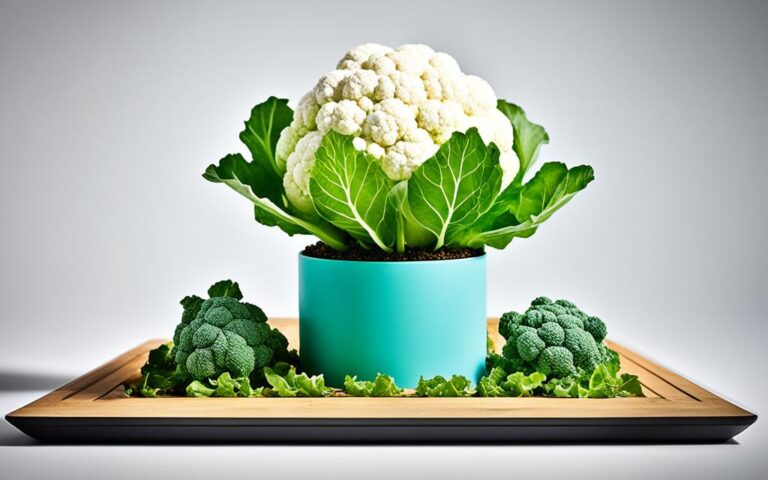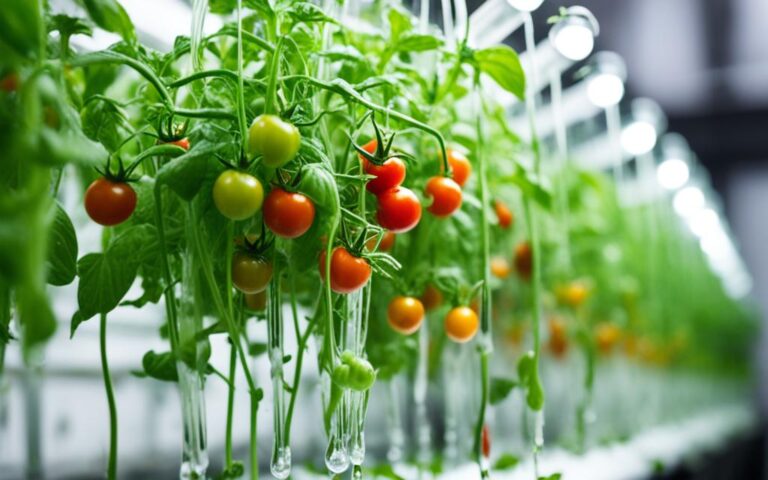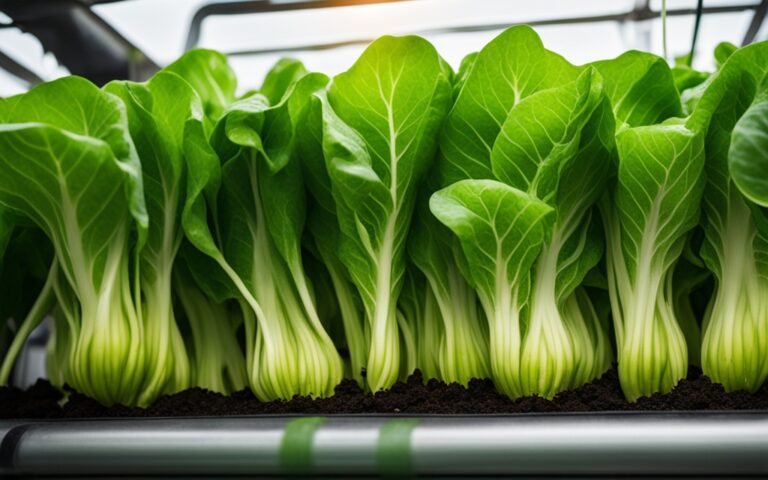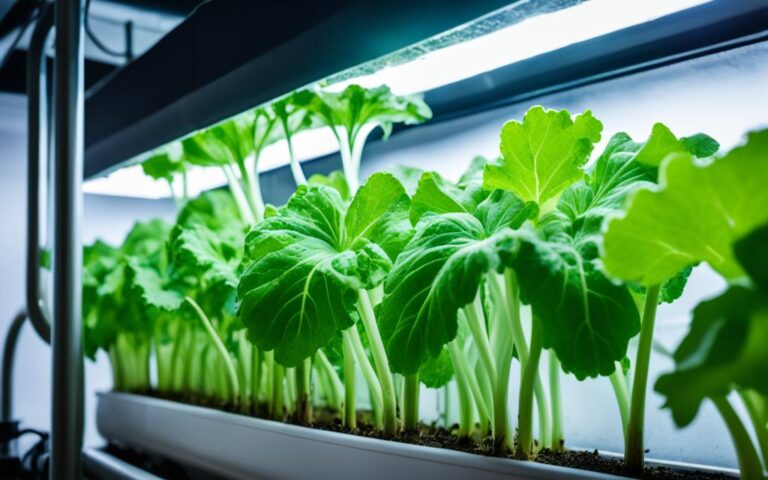Hydroponic Weed: Growing Cannabis Without Soil
Hydroponic growing is changing the game in cannabis cultivation. It’s a method that grows cannabis in water, not soil. This way, growers can control the plant’s growth better than ever before. It leads to faster growth and more plants compared to traditional soil methods.
More and more cannabis growers are choosing hydroponics. It offers big advantages over soil growing. These include using less water, making the most of space, growing all year, and getting strong, quality buds.
Key Takeaways
- Hydroponics is a soil-free method that gives plants direct access to water and nutrients. This leads to quicker growth and more plants.
- Growers are switching to hydroponics for its benefits like saving water, using space well, and growing all year.
- Hydroponic systems send nutrients straight to the roots, helping plants grow fast and possibly making buds stronger.
- Getting nutrients right, controlling light, and the environment is key to getting the best yields and potency from hydroponic cannabis.
- Hydroponics gives growers a lot of control but needs careful watching. Issues like nutrient problems or power cuts can harm the plants.
Table of Contents
What is Hydroponic Growing?
Hydroponics, also known as hydroculture or RDWC (Recirculating Deep Water Culture), is a way to grow plants without soil. Plants grow in water that has all the nutrients they need. This method gives plants direct access to water and minerals, making them grow faster and produce more than plants grown in soil.
Many cannabis growers choose hydroponics because it has many benefits over traditional methods.
The Benefits of Hydroponic Growing
Hydroponic growing has many advantages for growing cannabis:
- It uses up to 10 times less water than traditional soil-based methods.
- It takes up much less space, making it perfect for indoor and urban growing.
- Growers can cultivate cannabis all year, no matter the season.
- Hydroponic cannabis might have more cannabinoids and terpenes because of the direct nutrient access.
These benefits make hydroponics a top choice for growers who want to increase their yields and quality while using fewer resources.
“Hydroponics allows for precise control over the growing environment, leading to faster growth and higher yields compared to traditional soil-based cultivation.”
Hydroponic growing is a modern and efficient way to grow cannabis. It lets growers improve their production while reducing their environmental impact.
Advantages of Hydroponics for Cannabis
Hydroponics is better than traditional soil for growing cannabis. It uses up to 10 times less water, which is great for dry areas. Plus, plants grow more compactly, needing less space.
You can grow hydroponic cannabis all year, no matter the season. This is because you control the environment indoors. And, you get more water and nutrients, making the plants stronger and more potent.
Increased Yields and Potency
Hydroponic systems give plants exactly what they need, leading to bigger harvests. They help plants grow faster by giving them the right nutrients and more oxygen. This means you can get more from your plants than with soil.
Also, hydroponics makes cannabis plants stronger. They have more THC and CBD, which are the good stuff. This makes the cannabis better quality.
Efficient Resource Utilization
Hydroponics is good for the planet because it uses water and nutrients wisely. It cuts down on waste and saves resources. Plus, you can grow more plants in a small space, making the most of what you have.
Year-Round Cultivation
Hydroponics lets you grow cannabis all year, no matter the weather outside. You control the environment, so plants grow well all the time. This means you can have a steady supply of cannabis all year.
This way, you can always have cannabis ready for your customers. It’s great for meeting the demand for cannabis products.

“Hydroponics maximize grow environments, making them suitable for indoor and outdoor farms with limited space.”
Setting Up a Hydroponic System
To grow cannabis hydroponically, you need to gather the right equipment. This includes grow tanks, pumps, grow lights, and hydroponic nutrients. You also need a clean indoor space or greenhouse with good ventilation and power access.
The equipment needed changes based on the hydroponic system type. But, these are the main things you’ll need to grow cannabis without soil. Let’s look at the key equipment for a hydroponic cannabis setup:
Grow Tanks and Containers
- Grow tanks or containers to hold the water and nutrient solution
- These can be made from plastic, metal, or other durable materials
- Sizes can range from small 5-gallon buckets to larger 50-gallon reservoirs
- Ensure the containers are opaque or covered to prevent algae growth
Water Circulation Pumps
- Submersible pumps to circulate the water and nutrient solution
- Airstone pumps to provide oxygen to the roots
- Choose pumps with the appropriate flow rate for your system size
Grow Lights
- High-intensity grow lights, such as LED or high-pressure sodium (HPS) lamps
- Ensure the lights provide the necessary spectrum and intensity for cannabis growth
- Position the lights at the optimal distance from the plants
Hydroponic Nutrients
- A balanced nutrient solution formulated specifically for hydroponic cannabis cultivation
- Includes essential macro and micronutrients for healthy plant growth
- Adjust nutrient levels based on the growth stage of your plants
With these key components, you’re ready to set up a successful hydroponic system for cannabis. The setup may change based on the hydroponic method you choose. But, these are the main things you’ll need to start.
| Hydroponic System Component | Purpose |
|---|---|
| Grow Tanks/Containers | Holds the water and nutrient solution for the plants |
| Water Circulation Pumps | Moves the water and nutrients around the system |
| Grow Lights | Provides the necessary light spectrum and intensity for cannabis growth |
| Hydroponic Nutrients | Supplies the essential macro and micronutrients for healthy plant development |
Choosing the Right Hydroponic System
Choosing the right hydroponic system is key for growing cannabis well. There are many types, each with its own benefits and things to think about. Knowing the differences helps you pick the best one for your needs and growing space.
The Deep Water Culture (DWC) system is popular for growing cannabis. In this setup, the roots are in a nutrient-rich water solution. This gives plants direct and constant access to water and minerals. It’s simple, easy to use, and helps plants grow fast.
The Nutrient Film Technique (NFT) system is another good choice. It uses a stream of nutrient water over the roots. This method is efficient, produces high yields, and works well with many cannabis strains.
- Deep Water Culture (DWC) systems: Simple, fast growth, continuous water/nutrient access
- Nutrient Film Technique (NFT) systems: Efficient, high yields, suitable for diverse strains
- Ebb and Flow (Flood and Drain) systems: Flexible, suitable for both small and large-scale grows
- Aeroponics: Maximizes oxygen exposure, promotes rapid root development
Ebb and Flow (Flood and Drain) systems and Aeroponics are also popular. Ebb and Flow is flexible for any grow size. Aeroponics gives roots lots of oxygen, which helps them grow fast.
Think about space, budget, control level, and your experience when choosing a hydroponic system. Talking to experienced growers or hydroponic suppliers can also help pick the best setup for you.
| Hydroponic System | Key Advantages | Considerations |
|---|---|---|
| Deep Water Culture (DWC) |
|
|
| Nutrient Film Technique (NFT) |
|
|
| Ebb and Flow (Flood and Drain) |
|
|
| Aeroponics |
|
|
Understanding the unique traits and needs of different hydroponic systems helps growers choose the best one. This way, you can grow a thriving, high-yielding cannabis crop.

Nutrient Management for Hydroponic Weed
When growing cannabis hydroponically, getting nutrients right is key. You need to keep the pH level between 5.5 and 6.5 for the best nutrient uptake. Also, it’s important to give the right mix of nutrients like nitrogen, phosphorus, and potassium at the right times. This helps plants grow strong and boosts yields.
Importance of Nutrient Ratio and pH Control
In hydroponics, the N-P-K ratio matters a lot. Nitrogen helps with leaf growth and color, phosphorus aids stem, root, and flower development, and potassium helps with bud, stem, and root growth. You’ll find the N-P-K ratio on nutrient bottles, showing the percentage of each nutrient. The ratio changes with the plant’s growth stage, with more nitrogen in the early stages and more phosphorus and potassium later.
Keeping the pH level around 5.5-6.5 near the roots is best for nutrient uptake. Soil has more micronutrients like iron and magnesium than hydroponics, so hydroponics need to add these nutrients. Also, soil has more nitrogen, so hydroponics need more nitrogen in the early stages.
| Growth Stage | Nutrient Ratio (N-P-K) |
|---|---|
| Seedling | 1-1-1 |
| Vegetative | 3-1-2 |
| Flowering | 1-2-3 |
As plants move from vegetative to flowering, growers need to adjust the nutrient solution. This ensures they get the right nutrients for healthy growth and high yields.
“Proper nutrient management, including maintaining the ideal pH and providing the right nutrient mix, is essential for achieving healthy, high-yielding hydroponic cannabis plants.”
Light Requirements for Hydroponic Cannabis
Getting the right lighting for hydroponic weed is key to growing cannabis hydroponically. Cannabis needs a certain amount of light to grow well. Growers usually aim for 7,000-10,000 lumens per square foot for optimal growth and development of their hydroponic cannabis.
The kind of grow lights for hydroponic cannabis matters, like CFL or LED. Where you put them in the grow space also affects the light exposure. You can adjust this to fit the plants’ needs at different stages of their life.
Traditional HID (High-Intensity Discharge) lights like HPS (High-Pressure Sodium) and MHL (Metal Halide Lights) were once common. But LED lights are now popular for being energy-efficient and flexible. They provide the right spectrum for each growth phase of cannabis plants.
- Metal Halide lights are often used in the vegetative phase for their blue light, which helps plants grow bushy.
- HPS lights are best in the flowering stage because they give off orange and red light, helping buds form.
- LED lights are top picks for cannabis cultivation because they’re efficient, versatile, and don’t need extra gear like ballasts.
- Compact Fluorescent Lamps (CFL) add blue light in the vegetative phase and produce less heat.
The best light conditions for hydroponic marijuana change with the growth stage. In the vegetative phase, plants need 16-24 hours of light. In the flowering phase, they need 12 hours of light and 12 hours of dark. Getting light right is crucial for healthy plants and big yields.
Temperature and Ventilation Needs
Keeping the right temperature and good air flow are key for growing hydroponic weed. The best temperature for hydroponic weed is between 73°F and 80°F. If the temperature is too high or too low, the plants may not grow well.
Good air circulation helps keep pests away and supports healthy plants. For hydroponic marijuana, you need fans like inline, intake, exhaust, and oscillating fans. These fans make sure there’s always fresh air and remove the old, warm air.
Maintaining Optimal Temperature and Humidity
The best temperature and humidity change as the plants grow:
- Nursery/Clone Room: 70–85°F lights on, 65–80°F lights off; 65-80% humidity
- Vegetative Stage: 70-85°F lights on, 60-75°F lights off; 55-70% humidity (gradually lowering to flowering stage levels)
- Flowering Stage: 65-84°F lights on, 60-75°F lights off; 40-60% humidity
- Drying Room: 60-72°F; 45-60% humidity
Keeping these temperatures and humidity levels right is vital. It helps avoid stress, disease, and low yields. Using systems like chilled water or DX systems can help create the best conditions.
It’s crucial to control humidity during drying and curing to stop mold. Slow drying and curing are key for making hydroponic cannabis strong and tasty.
Selecting Suitable Cannabis Strains
Choosing the right cannabis strains is key when growing hydroponically. Indica-dominant strains work well because they grow short and fit well in hydroponic setups. Sativa-dominant strains do better outdoors, where they can stretch out fully.
Some strains are perfect for hydroponics because they grow fast, are tough, and handle pH changes well. Here are some top picks:
- GG4 (Gorilla Glue #4): This hybrid is super potent, with THC up to 25%. It does great in hydroponics and produces big, sticky buds.
- Purple Queen: A strong indica that’s good with pH changes in hydroponics. It turns purple and gives a strong, relaxing effect.
- Bubba Kush: A classic indica that does well in hydroponics. It makes dense, tasty buds with a lot of THC.
- Blue Dream: A versatile hybrid that does well in hydroponics. It offers a balanced effect and smells like blueberries.
- Amnesia Haze: A tall sativa that can do well in hydroponics. It gives an uplifting high and tastes citrusy.
When picking strains for hydroponics, think about growth time, how much you can expect to get, and the flavors. Checking lab reports on cannabinoids and terpenes helps pick the best strains for your setup and taste.

| Strain | Genetics | THC Content | Bloom Time | Yield Potential |
|---|---|---|---|---|
| Auto Ultimate | Indica-Dominant | Up to 20% | 12-15 weeks | XXL Yields |
| Auto Think Different | Sativa-Dominant | Up to 18% | 11 weeks | High Yields |
| Orange Hill Special | Indica-Dominant | Up to 25% | 8 weeks | High Yields |
| Glueberry OG | Indica-Dominant | Up to 24% | 8 weeks | High Yields |
| Mokum’s Tulip | Indica-Dominant | Up to 27% | 12 weeks | Heavy Yields |
| Auto Mokum’s Tulip | Indica-Dominant | Up to 24% | 12 weeks | High Yields |
“When selecting strains for hydroponic cultivation, growers should consider factors such as growth cycle length, yield potential, and terpene profiles to ensure the best fit for their specific growing environment and personal preferences.”
By looking at different strains and matching them with your hydroponic setup, you can increase your chances of a great harvest. This way, you can grow the best strains for hydroponic weed, indica vs sativa for hydroponic cannabis, and strain selection for hydroponic marijuana.
hydroponic Weed: From Seed to Harvest
Growing cannabis hydroponically is a precise and efficient process. It can yield impressive results. From the initial seed germination to the final product, each step needs careful attention and fine-tuning. Let’s explore the journey of growing hydroponic weed from seed to harvest.
The process starts with germinating the seeds in a growth medium like rock wool or coco coir. These are then put in the hydroponic system. As the seedlings grow, they get the right nutrients and water. The plants are kept in an optimal pH level between 5.5 and 6.5.
They also get the right lighting conditions. Growers watch and adjust the environment as needed.
- Seed Germination: The germinated seeds are planted in a suitable growth medium and placed in the hydroponic system.
- Vegetative Stage: The seedlings are supplied with the right nutrients and water, while maintaining the optimal pH and lighting conditions.
- Flowering Stage: As the plants progress through the flowering stage, growers continue to monitor and adjust the environment to ensure healthy, productive growth.
- Harvesting: Once the cannabis buds have fully matured, they are harvested, dried, and cured for consumption.
Attention to detail is key in the hydroponic cannabis cultivation process. Proper nutrient management, light exposure, and environmental control can boost the potency and yields of the hydroponic weed. By following these steps, growers can achieve a successful growing hydroponic weed from seed. They can enjoy the benefits of a high-quality, hydroponic marijuana harvest.
“Growing hydroponic weed can be a rewarding and efficient way to cultivate cannabis. With the right setup and care, you can enjoy the benefits of a bountiful, potent harvest.”
Common Issues and Troubleshooting
Hydroponic cannabis growing has many benefits, but it’s not without its challenges. Growers might face issues like nutrient imbalances, pH problems, pests, diseases, or equipment failures. It’s key to watch the grow space closely and fix problems fast to keep plants healthy and productive.
One big issue is overwatering, which can make plants droop, turn yellow, grow slowly, and have curled leaves. It’s important to water right and keep good air flow to avoid root rot. This happens when roots get mushy from too little oxygen.
Getting nutrients right is also vital in hydroponic cannabis growing. The ideal pH is 5.5-6.5, and the wrong pH can make plants show nutrient deficiencies, even if they have enough nutrients. Growers should check the root pH and tweak the nutrient mix to keep plants healthy and productive.
Pests and diseases can be tough in hydroponic setups too. Mold and mildew love dark, damp places, and pests like fungus gnats can cause root rot. Good ventilation, controlling humidity, and using natural bug sprays can help fight these problems.
| Common Issues | Troubleshooting Steps |
|---|---|
| Overwatering | Ensure proper watering and maintain excellent air circulation to prevent root rot. |
| Nutrient Imbalances | Monitor root pH and adjust the nutrient mix to maintain the ideal pH range of 5.5-6.5. |
| Pests and Diseases | Improve ventilation, control humidity, and use natural insecticides to prevent mold, mildew, and fungus gnats. |
| Equipment Malfunctions | Regularly inspect and maintain hydroponic system components to ensure optimal performance. |
By keeping an eye on the grow space, adjusting nutrients, keeping the right pH, ensuring good air flow, and tackling pests or diseases, growers can fix common problems. This way, they can have a successful hydroponic cannabis harvest.
“Maintaining excellent air circulation and controlling humidity levels are essential in preventing plant diseases that attack leaves in hydroponic systems.”
Maximizing Yields with Hydroponics
Cultivating cannabis with hydroponics can greatly increase yields and potency. By using different techniques and controlling the growing environment, growers can make the most of their hydroponic cannabis. This approach helps unlock the full potential of the plants.
Nutrient Management for High Yields
Getting nutrients right is key to high yields in hydroponic cannabis. Keeping the pH level between 5.8 and 6.2 helps plants absorb nutrients well. It’s important to give the right amount of nitrogen, phosphorus, and potassium at each stage of growth. This supports healthy growth and bud production.
Optimizing Light Exposure
Providing the right amount of light is crucial for boosting yields. LED grow lights are the best for giving plants the light they need. Adjusting the light’s intensity and duration helps plants focus on making more buds.
Environmental Control for Increased Potency
Controlling the grow environment helps increase potency and yields. The ideal temperature for germination and seedlings is 75-85°F (24-29°C), with 70% humidity. In the flowering stage, 12 hours of light and 12 hours of darkness each day triggers bud production.
Using these best practices can greatly improve increasing yields with hydroponic weed, maximizing potency of hydroponic cannabis, and best practices for high-yield hydroponic marijuana. This leads to exceptional results from hydroponic cannabis crops.
“Hydroponics has shown potential to increase yields by producing significantly higher yields per square foot compared to traditional soil-based methods.”
| Hydroponic Technique | Yield Increase vs. Soil |
|---|---|
| Deep Water Culture (DWC) | 30-50% higher yields |
| Ebb and Flow | 20-40% higher yields |
| Nutrient Film Technique (NFT) | 40-60% higher yields |
| Aeroponics | 50-100% higher yields |
Comparing Hydroponic vs Soil-Grown Cannabis
When looking at hydroponic and soil-grown cannabis, several key factors stand out. Hydroponic systems are great because they use less water, grow plants more compactly, and let you grow all year. They also give plants fast access to water and nutrients, which can make them grow faster and be more potent than soil-grown ones.
But, growing hydroponic cannabis needs more technical skills and special gear like grow tanks and pumps. On the other hand, soil-grown cannabis seems more natural and simple. It uses organic or synthetic nutrients in the soil to help plants grow.
| Hydroponic Cultivation | Soil-Based Cultivation |
|---|---|
| – Reduced water usage – Faster growth and higher potency – Year-round cultivation – Requires specialized equipment and expertise | – More natural and straightforward – Relies on organic matter or synthetic nutrients in soil – Slower growth during vegetative stage – Potential for lower yields compared to hydroponics |
Both hydroponic and soil-based methods can produce top-quality cannabis. The choice between them depends on what the grower likes, has access to, and the growing conditions. Soil cultivation may be preferred for those seeking a more natural process, while hydroponic cultivation might be better suited for growers aiming for higher yields, faster harvests, and a more controlled growing environment.
It’s worth noting that different hydroponic methods, like DWC, ebb and flow, and aeroponics, each have their own pros and cons. This makes it hard to directly compare hydroponic and soil-based methods. The decision to go with hydroponic or soil-grown cannabis should be based on what the grower needs, wants, and the growing conditions they have.
Future of Hydroponics in Cannabis Cultivation
The cannabis industry is changing fast, and hydroponic growing is becoming more important. New tech like automated systems and better nutrient delivery is making hydroponics more popular. It’s now easier for both big and small growers to use.
Hydroponics lets growers control the growing conditions perfectly. This means they can get more yield and stronger plants. Big cannabis producers like this because it helps them make high-quality products. As more states legalize cannabis, hydroponic weed growing will be key to the industry’s growth.
Future Grow Solutions is a company leading the way in hydroponic cannabis growing. They aim to get 25 pounds of cannabis every eight weeks from a small space. They plan to grow smokable weed, oils, and edibles for dispensaries in a big facility.
Mark Savaya, the owner, wants to lease his hydroponic tech to other growers. He says it uses much less energy than traditional indoor farms. The first location is in Livernois, Detroit, and they’re planning to grow in other areas if it works out.
Some growers prefer soil for flavor, but Savaya believes hydroponics gives a consistent product. With ongoing tech improvements, hydroponics will likely play a big part in the cannabis industry’s future.
| Key Advantages of Hydroponic Cannabis Cultivation | Emerging Trends in Hydroponic Weed Cultivation |
|---|---|
| Reduced water usage Less space required Effective year-round cultivation Higher potency |
|
The cannabis industry is changing fast, and hydroponic growing is getting more important. The advancements in hydroponic tech and its role in the cannabis industry’s future are key to its growth.
“The future of hydroponic weed cultivation is poised to play a significant role in the cannabis industry’s evolution.”
Conclusion
Hydroponic growing is a top choice for cannabis cultivation. It cuts out soil and gives plants direct access to water and nutrients. This leads to faster growth, more yields, and stronger plants compared to soil-based methods.
Starting and keeping up a hydroponic setup needs more technical skills and gear. But, the benefits make it a smart choice for both big and small growers.
The cannabis industry is changing fast, and hydroponics will likely play a bigger part. New tech and the need for reliable, high-quality products are pushing it forward. Hydroponic growing is great for saving water, fitting into small spaces, and growing all year.
Key points for growing hydroponic cannabis include managing nutrients, lighting, and the environment well. This helps get the best yields and potency. As the cannabis world changes, hydroponics will become more important.






